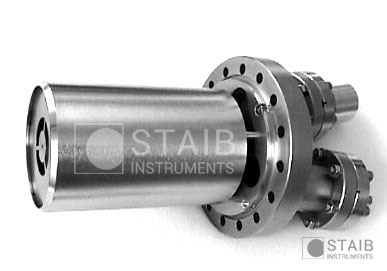Depth Profiling – Related STAIB Instruments Products
What is Auger Electron Spectroscopy (AES)?
Principle
The sample is bombarded with an electron beam of sufficient energy to create core level ionizations, leaving a hole in a specific electronic shell. Recombination occurs by filling the hole with an electron from an outer energy level. The released energy is carried outside either by an X-ray photon or another electron from the atom, the Auger electron. Like for X-ray emission, the energy of the Auger electron is characteristic of the atomic element and does not depend on the energy or kind of excitation used.
Technique
The sample (gas or solid) is bombarded by a focused electron beam of 3 to 10 keV energy. The energy of the emitted electrons is analyzed by a highly sensitive energy analyzer, in which the filter energy (so called Pass Energy) is scanned over the Auger lines and the signal is detected using an electron multiplier. The measured energy distribution is digitalized and displayed by a computer program. Data are saved in various formats for processing and quantification.
Set up
The minimal configuration is an electron gun of 3-10 keV energy and an energy analyzer. The best design is to have the electron gun built into the analyzer. Modern analyzers have a selectable energy resolution and large working distance (offering good sample clearance). The STAIB ESA-family is optimized for AES and provides the most advanced compact analyzer design on the market.
Useful options
- It is important to analyze clean, contamination free samples. The most practical and universal cleaning method is the use of an ion beam (of Argon or other heavy gases) to sputter away the surface layers (which are mostly contamination).
- Ion sources can also be used for Ion back-Scattering Spectroscopy (ISS), and AES depth profiling.
- Excitation for AES can be operated with any electron source, provided it delivers a very low noise, stable beam in the correct energy range. When combined with a micro-focus source (delivering a small spot of high spatial resolution), very small sample areas can be analyzed, down to about 100 nm. Scanning Electron Microscopy (SEM) and Scanning Auger Microscopy (SAM) utilize a beam that is scanned over the sample, to map the surface elements.
- Computer control of the analyzer system allows users to pre-set series of measurements (i.e. for over night).
- Special systems have been designed to perform AES measurements at higher vacuum pressures, i.e. see AugerProbeTM.
- Very compact AES analyzers, with small diameter and large working distance, can be used in systems where the space available is very tight (like MBE chambers).
Minimal requirements for depth profiling using AUGER:
- Depth profiling software module
- Sample current measurement kit
Optional additions:
- Sample imaging package
- Microfocus and nanofocus electron sources
Related STAIB INSTRUMENTS products:
What is Photoelectron Spectroscopy using X-rays (XPS)?
Principle
The sample is illuminated with X-ray radiation of sufficient energy to create core level ionizations of the atoms. The photon energy is transferred to the electron, with some leaving the sample as photoelectrons. The kinetic energy of the emitted photoelectron is given by the difference between photon energy and binding energy of the electron in the sample. Unlike for X-ray or Auger emission, the energy of the photoelectron depends on the X-ray energy used. As X-ray radiation is almost monochromatic, the energy of the measured line can be simply converted into binding energies.
Technique
An X-ray source producing quasi-monochromatic radiation (using Al or Mg anodes) is used to generate photoelectrons of different energies. The energy of the emitted electrons is analyzed by a highly sensitive, high energy resolution energy analyzer. The filter energy is scanned over the photoelectron lines and the signal is detected using an electron multiplier. The measured energy distribution is digitalized and displayed by a computer program. Data are saved in various formats for processing and quantification.
Set up
The minimum configuration requires an X-ray source and a high resolution energy analyzer suitable for XPS. The X-ray source is equipped with two anodes, Al and Mg, delivering different photon energies so that the photoelectron lines can be differentiated from the Auger lines (at fixed kinetic energy). Modern analyzers have selectable energy resolution and large working distance (good sample clearance). Having the electron source built into the analyzer provides ease of use and alignment, with full AES capability on a single flange. The STAIB DESA- family is optimized for XPS and AES.
Useful options
- It is important to analyze clean, contamination free samples. The most practical and universal cleaning method is the use of an ion beam (of Argon or other heavy gases) to sputter away the surface layers (which are mostly contamination). The same ion source can be used for Ion back-Scattering Spectroscopy (ISS).
- Computer control of the analyzer system allows users to pre-set series of measurements (i.e. for over night).
- When combined with a micro-focus source, full Auger capabilities become available, including AES, SEM and SAM.
- A special low energy electron source can be used for charge compensation on isolating samples.
Minimal requirements for depth profiling using XPS:
- Depth profiling software module
- Dual anode X-ray source package
Optional additions:
- Sample imaging package
- Microfocus and nanofocus electron sources
Related STAIB INSTRUMENTS products:

